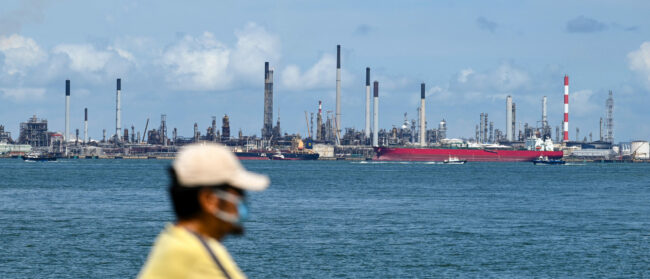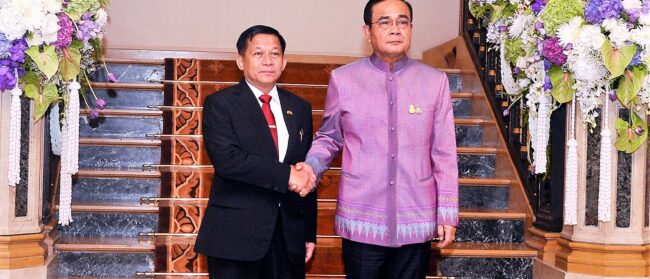Mekong River levels are expected to rise as hydropower dams in the Upper Basin begin releasing water from upstream reservoirs. These dry season releases will affect the river’s natural flow, experts said, altering livelihoods across the basin.
Regional specialists tracking the ebb and flow of the Mekong addressed the expected social and ecological impacts on the Lower Basin during a 15 February online discussion titled, “Where’s the Water: Mekong Dry Season 2022.” Experts at the event hosted by the Stimson Center, a U.S. think tank, also proposed solutions for improving river management.
The Mekong River flows through China, Myanmar, Thailand, Laos, Cambodia and Vietnam. The tropical river system is influenced by a monsoonal climate with a dry and wet season. The seasonal change in water flow and level is referred to as a ‘flood pulse.’
Last year was the ninth driest on record in the Mekong Basin, according to an analysis of Mekong River Commission data by the Stimson Center. The last three consecutive years have been among the top 10 lowest annual flows on record, with 2020 in first place and 2019 in seventh.

Where’s the water?
Alan Basist, president of Eyes on Earth and co-lead of the Mekong Dam Monitor, attributes the record-low water levels to climatic warming conditions compounded by hydropower dam operation and land use changes.
“Climate change is not just in one direction. The thing we’re noticing most is the atmosphere’s capacity to hold water is promoting more extreme events in both directions,” Basist said at the 15 February event, explaining warmer atmospheres can hold more water.
Alterations in land use for development are also diverting water from Cambodia’s Tonle Sap Lake, which depends on the water contribution for the lake’s natural flow reversal. On top of changing land use, extreme weather conditions contribute to the lack of rainfall and snowmelt during wet season, which also normally supplements the Mekong’s water supply.
Hydropower operations compound this lack of additional water.

Reservoirs and dams are “altering the pulse” of the river’s natural flow during the wet season. “The water that would naturally pulse down is being held so it can be released for hydroelectricity during the dry season,” Basist said.
The Mekong Dam Monitor, a collaborative project between the Stimson Center and Eyes on Earth, tracks 45 of the largest dams in five countries on the river system.
The 11 hydropower dams in China and 21 in Laos followed by the Mekong Dam Monitor hold nearly 89% of the water stored in all monitored dams. In total, these dams store 43.86 cubic kilometres (10.52 cubic miles). The units measure capacity equalling the volume of a cube with edges of 1 kilometre (or mile.)
The region’s reliance on the Mekong’s production of hydroelectricity seems set to continue. The Stimson Center’s Mekong Infrastructure Tracker reported at least 39 hydropower projects in construction as of late January.
The key country in the dam development discussion is Laos, said Courtney Weatherby, Stimson Center Southeast Asia program deputy director.
“We know China’s moving ahead with dam construction and there’s very little that can be done to change that. Cambodia has sort of shelved its two projects for the interim,” Weatherby said. “But Laos has four projects which have already gone through the Mekong River Commission review process.”

The dams are not actively under construction because no market has emerged ready to purchase the hydroelectric power.
While Thailand is a major consumer of Laotian electricity, the nation has “a lot of extra electricity right now,” leading to uncertainty about whether a power purchase agreement will be signed, Weatherby said.
“There’s still space to talk about what is going on, what has to happen in terms of dam construction and what is optional, what could be replaced with alternative energy sources,” Weatherby said. “There are still options on the table apart from mainstream dams that wouldn’t have the same environmental and social impacts… but would still meet regional energy needs.”
Weatherby was the lead author of a 2021 study identifying cheaper alternatives for Thailand’s power purchases, such as tributary hydropower dams and floating solar projects built on dam reservoirs.
The experts who were contacted agreed that further hydropower development would likely cause further damage to the Mekong. Brian Eyler, Stimson Center Southeast Asia program director and co-lead of the Mekong Dam Monitor, also noted the way current dams operate is a key compounding factor.
“During these really dry years, the way the dams are operated tends to hurt more, tend to impact the natural ecology, the resource provision and the communities downstream more because they’re taking a relatively larger amount of water out of the river,” Eyler said.

Effects downstream
Consecutive annual low-water flows endanger aquatic ecosystems, wildlife habitat and riverside communities. Tonle Sap Lake, which is vital to the regional fishing industry, is particularly vulnerable to the water shortage, Basist said.
“The flows are not occurring as they would naturally happen without all these dams altering the natural rhythm of the river,” he said.
A Mekong River Commission technical paper in 2021 confirmed hydropower development and environmental changes, specifically flow and climate change, were contributing stressors to the Lower Basin’s fisheries.
A follow-up study last year on the social impact of the Mekong found communities had grown more dependent on fishing in Cambodia and Vietnam, increasing their vulnerability to river-wide changes.
Low water flows impact the fishing industry by reducing the transfer of sediments, which bring nutrients to aquatic ecosystems.
“The faster the flow, the more sediment,” Basist said.
When the flow of water is interrupted by a dam during wet season, sediments in the water sink to the bottom of the dam’s reservoir. When released during dry season, the water no longer carries as much sediment. This will have a severe impact on the river delta’s integrity and the quality of life of the people there, Basist said.
An unnatural rise in the Mekong’s water level during dry season caused by reservoir releases can also affect native birds.

“Birds nest and lay eggs alongside the river’s course during dry season because the sandy banks are exposed. It is a perfect place for birds to find habitat,” Eyler said.
“When they let a lot of water out of the dams upstream, it can flood out the nest and kill the eggs and therefore threaten critically endangered species.”
The White-shouldered Ibis, which is listed as critically endangered by the International Union for Conservation of Nature (IUCN), is one of the species about which Eyler is most concerned.
The protected ramsar, or wetland, site on the Mekong River mainstream between the Laotian border and Stung Treng in northeastern Cambodia are among the locations Eyler plans to watch throughout the 2022 dry season, which could also threaten riverside communities.
“In the context of climate change, we should expect extreme events,” said consultant Nguyen Huu Thien, who has worked with the World Wildlife Fund, the International Centre for Environmental Management and the IUCN. “We’ve been talking too much about drought, but we should also not forget an extreme event on the other opposite extreme.”
While an extreme El Niño event could deepen droughts, a severe La Niña event could cause flooding downstream. El Niño and La Niña are opposing climatic patterns in the Pacific Ocean that can affect weather worldwide. This can shift the monsoonal season of the river, Thien said.
“The reversal can be confusing for the entire ecosystem because the entire ecosystem of the Mekong, especially migratory fish, depends on the pulse of the floods for starting the lifecycle activities, such as migration,” he said.
As a safety precaution during an extreme La Niña event, hydropower dams may also release water, which Thien said would “create double flooding.”
“I don’t know what kind of disaster that is going to create for the people down in Phnom Penh sitting right on the bank and for us down here in the corridors of the rivers, where the water will rush down,” said Thien, who is based in Vietnam.
Suggested solutions
The Mekong River Commission issued a regional call in January for better river management, following the third consecutive year of record-low flows. Suggestions from commission CEO An Pich Hatda included establishing a notification system for unusual water level fluctuations and exploring coordinated management of reservoirs and hydropower dams.
“Data sharing is the first of many steps that need to happen,” Weatherby said, noting this would require international coordination. “You really can’t have successful negotiations if people are starting on entirely different pages, or even entirely different chapters, of a book about what is available and what can be done.”
If data is shared and all books flipped to the same page, water use negotiations would be the next step. Eyler and Basist said a crucial element would be dialogue with the Chinese government, which stores the most water, operates some of the largest dams and has plans to build more.
Eyler emphasised the importance of China joining a new international agreement similar to the 1995 Mekong Agreement, signed by Cambodia, Laos, Thailand and Vietnam, which stipulates dams are to be designed and operated to maintain a minimum monthly water flow.
“The Tonle Sap Lake and its reversal and flooding process is built into the heart and the reason and the logic of the Mekong Agreement,” Eyler said. “Dams have their impacts, they have impacts to fish, they have an impact on sediment, for sure. But their hydrological impacts on the pulse of the river that creates the Tonle Sap reversal are minimal.”
If dams are built to facilitate flows to Tonle Sap Lake, the dams can also provide relief downstream by releasing water during anomalously low wet seasons.
But for this to happen, countries in the Lower Basin, such as the four signatories of the Mekong Agreement, would need to provide an incentive for dam operators in China to release water during wet season and forgo the financial gains of holding water in reservoirs for hydropower production during dry season.
Basist explained the idea of regional reinsurance in this hypothetical incentive.
“The reinsurance industry could be collecting money from the Lower Basin and using those funds to basically offset the financial loss to China,” Basist said. “One of the benefits of insurance is to protect against extreme events… the benefit far outweighs the cost of having such an insurance policy set up in advance.”
An audience member at the Stimson Center’s “Where’s the Water” event disagreed with the idea of reinsurance and compensation, suggesting focus be put on encouraging policy makers to pursue alternative energy solutions.
Eyler countered that the reality is dam construction in China is motivated by profit, with legal contracts determining power production and allocation. Developing a reinsurance policy to mitigate extreme events may be the most equitable option, since the Mekong’s fishing communities wouldn’t necessarily be paying.
“When you ask somebody to stop doing that, you’ve got to give something in return,” Eyler said.
Photos by Anton L. Delgado


